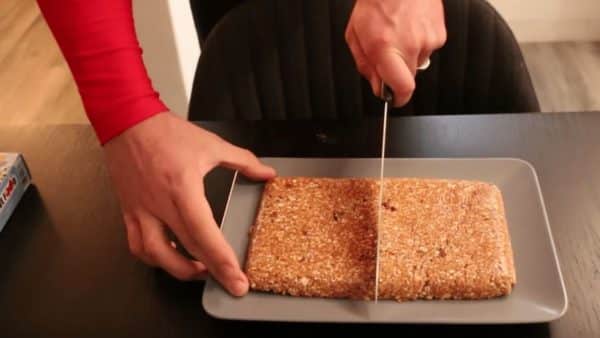Bien connue des pratiquants de musculation et des bodybuilders, la sèche est une technique visant à éliminer de la masse graisseuse, tout en préservant au maximum la masse musculaire. Mais quel régime alimentaire faut-il suivre ? Quel type d’entraînement faut-il privilégier ? Et comment savoir si son programme de sèche fonctionne ou non ?
Vous l’avez compris, perdre du gras tout en limitant la fonte musculaire ne s’improvise pas. Dans cet article, je vous détaille comment faire une bonne sèche en 7 étapes.
Faire une sèche, en bref :
- La sèche vise à perdre du gras tout en préservant la masse musculaire.
- Elle repose sur un déficit calorique et un entraînement adapté.
- Il faut ajuster les macronutriments : protéines élevées, glucides contrôlés, lipides modérés.
- Faire de la musculation est essentiel pour limiter la fonte musculaire.
- Le HIIT et le cardio modéré peuvent compléter la sèche, mais doivent être bien dosés.
- Suivre ses progrès avec des mesures précises (tour de taille, impédancemètre) est clé.
- La durée idéale d’une sèche est d’environ 3 mois.
Sommaire
Étape 1 : comprendre ce qu’est une sèche musculaire
Qu’est-ce qu’une sèche ?
Il s’agit d’une méthode dont l’objectif est de perdre de la masse grasse sans compromettre le développement musculaire (on parle d’ailleurs de masse sèche).
En ce sens, la sèche diffère d’une perte de poids classique ou d’un régime minceur, où seuls les kilos en moins sur la balance comptent. Lors d’une sèche, il est tout aussi important de veiller à la cohérence de la composition corporelle.
Cette approche repose sur 2 grands piliers, que nous détaillerons dans les étapes suivantes :
- La mise en place d’un plan alimentaire hypocalorique
- Le suivi d’un programme d’entraînement adapté à la salle de sport
C’est le subtil équilibre entre ces 2 éléments qui vous permettra d’atteindre votre objectif. En d’autres termes, vous devez réduire votre apport calorique d’un côté (sans négliger les macronutriments, nous y reviendrons !), et augmenter votre dépense énergétique de l’autre en pratiquant une activité physique.
Une bonne sèche permet d’obtenir un physique sculpté, musclé et harmonieux.
En tant que coach sportif, une question qui revient souvent chez les hommes est : « Comment sécher au niveau du ventre ? ». Malheureusement, il est impossible de cibler une partie du corps en particulier. En faisant une sèche, vous allez certes mincir du ventre, mais aussi des cuisses, du torse, etc.
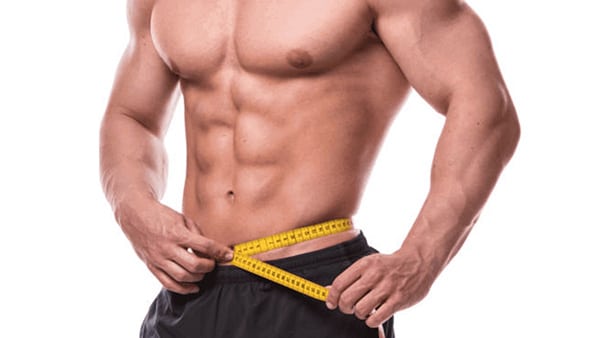
Étape 2 : savoir quand faire une sèche
Savoir comment sécher est une chose. Mais êtes-vous sûr que ce soit le bon moment ?
En règle générale, un athlète ou un pratiquant de muscu se lance dans une sèche après avoir terminé une phase de prise de masse durant laquelle il aura été plusieurs mois en surplus calorique.
Une fois la croissance musculaire aboutie, la sèche permet d’effacer l’excès de masse graisseuse.
Le but de cette pratique est donc de sculpter la silhouette, en faisant brûler le gras pour rendre la masse musculaire plus visible.
En résumé, le moment propice pour entamer une sèche est lorsque vous constatez que vos muscles commencent à disparaître sous votre tissu adipeux.
En ce sens, le calcul de votre taux de masse grasse peut vous aider à déterminer le moment idéal pour démarrer. Si le résultat est supérieur à 17 % environ (son interprétation dépend aussi de votre âge), il peut être pertinent d’essayer de sécher.
Étape 3 : calculer son besoin calorique
Savoir composer sa diète joue un rôle important dans la réussite d’une sèche. Cette partie vous explique comment bien vous nourrir pour préserver la masse musculaire et perdre le plus de gras possible.
Une alimentation de sèche repose toujours sur la mise en place d’un déficit calorique. Autrement dit, il est indispensable de consommer moins de calories que ce que vous en dépensez sur une journée. Si vous en mangez plus, vous prendrez du poids.
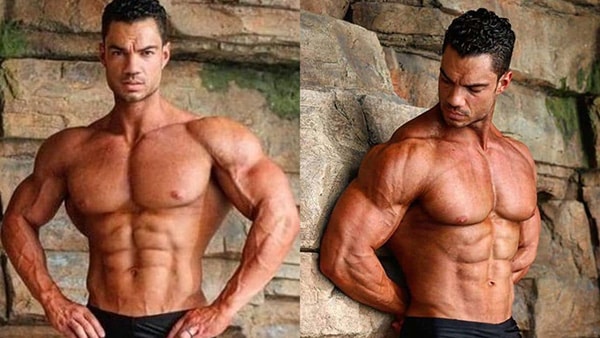
Il est essentiel de savoir évaluer ses besoins pour sécher efficacement. Toutefois, les besoins caloriques varient d’un individu à l’autre. Ils dépendent de plusieurs facteurs :
- Votre niveau sportif
- Votre morphologie de base
- Votre métabolisme
- Votre taille
- Votre poids
- Votre âge
- Votre sexe
Cela implique que pour perdre du poids, vous devez légèrement réduire votre apport calorique quotidien. Dans le cadre d’une sèche musculaire, il convient de diminuer d’environ 15 % la quantité de calories ingérées. Un tel changement ne doit pas avoir d’impact sur votre poids musculaire, mais doit au contraire influencer votre masse graisseuse.
Votre déficit calorique doit donc être progressif. S’il est trop violent, vous perdrez du poids, mais également votre masse musculaire.
Vous trouverez sur mon site un calculateur de calories entièrement gratuit. N’hésitez pas à l’utiliser pour mettre en oeuvre votre déficit.

DÉCOUVREZ MON CALCULATEUR DE CALORIES
Étape 4 : déterminer la répartition des macronutriments
L’étape suivante consiste à faire une évaluation de l’apport en macronutriments de votre alimentation. Pour faire une bonne sèche, il est très important de respecter un bon équilibre entre la consommation de protéines, de lipides et de glucides.
| Macronutriment | Quantité recommandée par kilo de poids de corps | Exemple pour un individu de 70 kg |
|---|---|---|
| Protéines | 1.5 – 2.5 g | 105 – 175 g |
| Glucides | 2.5 g | 175 g |
| Lipides | 0.5 – 1 g | 35 – 70 g |
Les protéines
Les protéines sont essentielles dans le cadre d’une sèche en musculation. Elles préservent votre masse musculaire et favorisent l’hypertrophie. Elles aident également à réparer les fibres musculaires après une séance d’entraînement.
Vous aurez besoin d’un apport compris entre 1,5 et 2,5 grammes de protéines par kilo de poids de corps.
À titre d’exemple, pour un individu de 70 kilos, l’apport journalier en protéines doit se situer entre 105 et 175 grammes durant une diète de sèche.
Un régime hyperprotéiné vous aidera à atteindre votre objectif plus facilement et plus rapidement. N’hésitez pas à varier les sources de protéines, qu’il s’agisse de protéines animales ou de protéines végétales.
Voici une liste d’aliments riches en protéines à inclure dans votre programme alimentaire :
- La volaille (poulet, dinde, etc.)
- La viande maigre, comme le boeuf à 5 % de matières grasses
- Le thon et le saumon
- Les oeufs
- Les légumineuses
- Le fromage blanc ou le skyr
- Le tofu et le soja
- La whey protéine
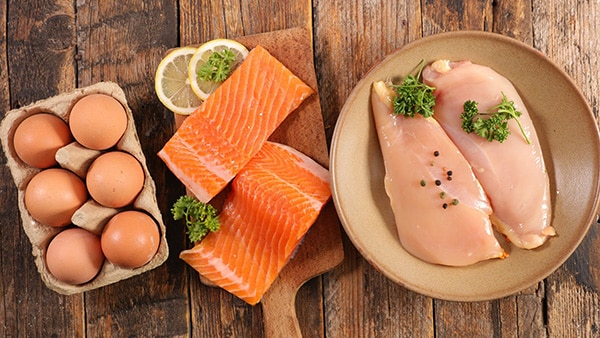
Les glucides
Lors d’une sèche, les glucides font office de variable d’ajustement. Vous pouvez donc vous en servir pour compléter ou réduire votre apport calorique journalier. Leur consommation doit correspondre à environ 2,5 grammes par kilo de poids de corps.
Il est préférable de privilégier les glucides à faible index glycémique, étant donné qu’ils ne font pas augmenter votre taux d’insuline. Sachez néanmoins que l’indice d’un aliment ne se prend pas en compte seul. En effet, il peut baisser s’il est mélangé à d’autres.
En revanche, vous devrez bannir de votre alimentation les sucreries, les graisses de friture ou encore les confiseries. Remplacez-les par des céréales complètes, de la patate douce ou des légumes à la vapeur.
Petite astuce : pensez à ajouter des épices dans vos recettes pour donner plus de goût à vos plats.
Les lipides
Beaucoup de sportifs, souvent débutants, ont tendance à supprimer complètement les lipides dans leurs repas de sèche.
C’est une erreur, car les lipides sont de précieux alliés pour votre santé, à la fois pour votre coeur et pour votre santé hormonale. Toutefois, veillez à ne conserver que les lipides essentiels.
Pour trouver de bons lipides, tournez-vous vers les poissons gras, l’avocat, les oléagineux ou encore les huiles végétales.
L’apport recommandé durant la période de sèche est de 0,5 à 1 gramme par kilo de poids de corps, soit 25 à 30 % de votre apport calorique total.
Plus largement, il est recommandé de réduire votre consommation d’aliments transformés et autres produits industriels (aliments riches en sucre raffiné, viennoiseries, plats préparés, alcool, sodas, fast foods, etc.). Privilégiez toujours une alimentation simple, à base de produits naturels tels que les fruits et légumes.
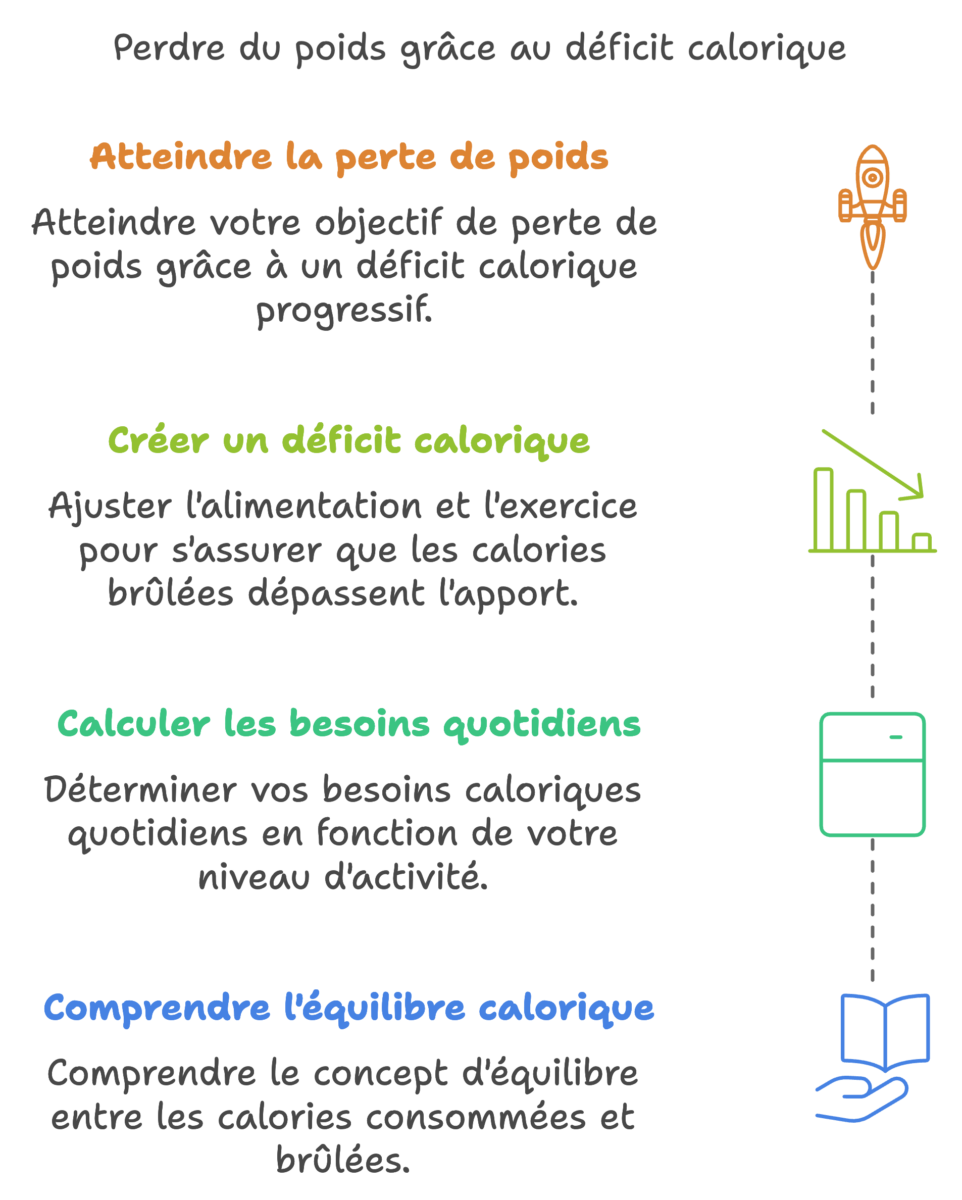
Étape 5 : mettre en place votre diète de sèche
Bien choisir vos aliments
Quels aliments manger pour sécher ? Voilà une autre question qui revient souvent.
Comme évoqué précédemment, optez de préférence pour des aliments les moins transformés possible. Et lorsque vous achetez des produits ayant subi une transformation, favorisez ceux dont la liste des ingrédients est la plus courte possible.
Ensuite, sachez que certains aliments sont considérés comme des brûleurs de graisse naturels. Bien sûr, ils ne sont pas obligatoires en période de sèche. Mais ils peuvent vous aider à perdre du poids plus rapidement.
Les aliments brûle graisses sont très pauvres en calories. Du coup, ils ne risquent pas d’augmenter votre masse graisseuse. L’artichaut, le citron, le pamplemousse, la pomme, l’ananas, le céleri, le persil ou encore la papaye sont d’excellents atouts pour votre diète.
Il en est de même pour les aliments rassasiants, car ils vous aident à ressentir la satiété et à ne plus avoir faim. Ce sont généralement des aliments riches en fibres, comme les fruits, les légumes, les flocons d’avoine, les noix ou les graines. Il existe un indice de satiété (IS) vous permettant de savoir si un aliment a un pouvoir rassasiant ou non.

Enfin, d’autres aliments ont des vertus stimulantes essentielles pour favoriser les dépenses caloriques de l’organisme. C’est notamment le cas du guarana, du café, du thé et de tous produits présentant une forte teneur en caféine.
Pour terminer, n’oubliez pas l’importance d’une bonne hydratation, avec au moins 2 litres d’eau par jour.
2 exemples de menus pour votre sèche
Pour vous aider à atteindre vos objectifs, voici 2 menus de sèche à 1 500 calories par jour, faciles à mettre en place.
Menu 1 :
| Repas | Aliments |
|---|---|
| Petit-déjeuner |
|
| Collation du matin |
|
| Déjeuner |
|
| Collation de l’après-midi |
|
| Dîner |
|
Menu 2 :
| Repas | Aliments |
|---|---|
| Petit-déjeuner |
|
| Collation du matin |
|
| Déjeuner |
|
| Dîner |
|
Pour plus d’idées de recettes de sèche sans frustration, découvrez mon e-book « Musclez vos plats ».
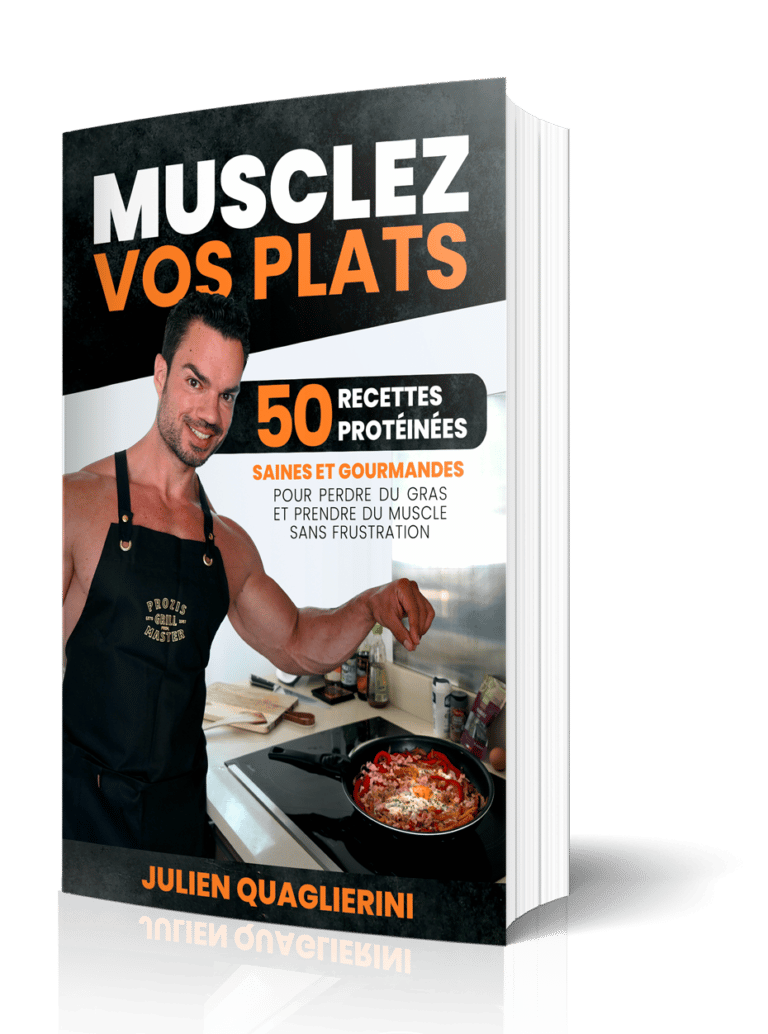
DÉCOUVREZ MON E-BOOK DE RECETTES
Et les cheat meals dans tout ça ?
Je vous recommande d’inclure un cheat meal par semaine dans votre programme alimentaire. Cela vous permettra d’entretenir votre motivation tout en boostant votre métabolisme.
Privilégiez des repas de triche sains, plutôt que des fast-foods ou des sucreries. Je vous propose d’ailleurs 4 idées de cheat meals healthy et délicieux dans cet article.
Faut-il prendre des compléments alimentaires ?
De nombreux suppléments spécialement conçus pour perdre du poids sont proposés dans le commerce. Mais ces compléments alimentaires sont-ils vraiment indispensables ?
La réponse est : non.
Si vous vous demandez comment perdre de la masse graisseuse, il n’existe pas de recette miracle. Le succès d’une sèche dépend essentiellement de 3 paramètres : l’alimentation, l’entraînement et le sommeil.
L’action des compléments n’est que très infime. C’est d’ailleurs une grosse erreur de penser que de tels produits peuvent remplacer une bonne alimentation.
Certains peuvent toutefois vous aider à sécher. C’est notamment le cas des protéines en poudre. Elles ont été créées pour couvrir vos besoins en protéines journaliers, sans avoir à consommer des aliments solides qui apporteraient en plus des lipides ou des glucides.

LA BIBLE DES COMPLÉMENTS ALIMENTAIRES
Découvrez TOUT ce qu’il est important de savoir sur les compléments afin de les utiliser à VOTRE avantage pour atteindre VOS objectifs !
L’avantage de cette forme de protéines, c’est qu’elle est plus économique et plus pratique que les sources de protéines animales classiques. Quoi qu’il en soit, elles n’ont absolument pas vocation à se substituer à des repas réguliers. En consommer une fois par jour, en collation par exemple, est largement suffisant.
Personnellement, j’utilise la whey isolate pure native de chez Prozis, car elle est d’excellente qualité. Elle fournit plus de 20 grammes de protéines par dose.
En ce qui concerne les produits brûleurs de graisses, leur mode d’action est similaire à celui d’un aliment brûle graisse. Ils stimulent le métabolisme et accentuent la dépense calorique de l’organisme. Leur ingestion favorise l’évacuation des graisses accumulées par notre corps.
Cependant, ne pensez pas que la seule consommation d’un brûleur de graisses vous aidera à sécher plus rapidement. Leur efficacité dépend de nombreux autres éléments, dont le niveau d’activité sportive et la qualité de votre alimentation. Leur rôle est surtout de réduire l’impact de la diète hypocalorique sur votre santé et d’éviter les sensations de fatigue qui accompagnent généralement les régimes amincissants. Enfin, ces produits sont surtout recommandés en fin de sèche, pour perdre les derniers kilos.
Étape 6 : construire un programme d’entraînement adapté
Vous pourriez être tenté de changer votre entraînement. Effectivement, vous aurez besoin d’un programme de musculation de perte de poids. Ceci est évident, puisque durant cette période, vous devez diminuer l’apport en calories. Alors, comment s’entraîner pendant une sèche ?
Le plan d’entraînement
Programmez au minimum 3 séances de musculation par semaine. Si vous êtes un pratiquant expérimenté, 5 entraînements serait un volume idéal.
Dans les faits, l’entraînement de muscu en sèche n’est pas fondamentalement différent de celui d’une prise de masse.
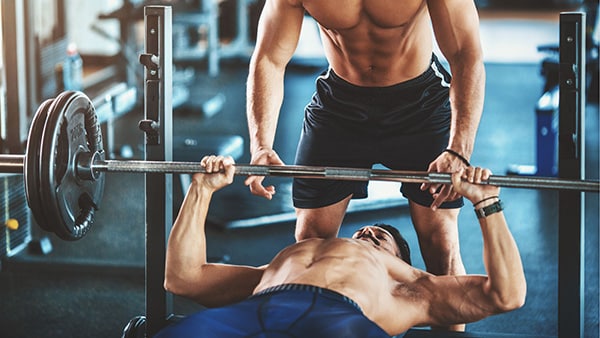
Contrairement à certaines idées reçues, il n’est pas nécessaire de faire des séries longues et rapides avec des charges légères. Au contraire, car ce type d’entraînement favorisant l’endurance, il est moins efficace pour limiter la fonte musculaire.
Il est ainsi préférable de travailler lourd pour conserver votre force et vos muscles. Pour plus d’efficacité, intégrez des techniques d’intensification comme les supersets, les bisets, trisets ou encore les dropsets. Il est aussi possible de réduire légèrement le temps de récupération entre les séries.
Le gros de vos séances doit être composé d’exercices de base (développé couché, squat, tractions, soulevé de terre, etc.). Ces mouvements seront complétés par des exercices d’isolation, en veillant à solliciter l’ensemble des groupes musculaires.
Prévoyez 4 à 5 séries par exercice, avec un nombre de répétitions compris entre 6 et 12.

ENVIE D’UN PHYSIQUE ULTRA SEC ET VOLUMINEUX ?
Faut-il faire du HIIT ?
Contrairement à une prise de masse, un programme d’entraînement de sèche peut aussi intégrer du HIIT (High interval intensity training).
Ce type d’entraînement repose sur une alternance entre un effort cardio à haute intensité et des phases de récupération active.
Un entraînement HIIT dure en moyenne 15 à 20 minutes. Cette méthode est généralement réservée aux athlètes confirmés, et totalement contre-indiquée pour les personnes obèses ou en surpoids.
Le HIIT a la capacité de vous aider à perdre de la masse grasse, d’autant qu’il vous permet de continuer à brûler des calories même plusieurs heures après la fin de la séance.
Attention, le cardio HIIT est très intense et n’est pas adapté à tout le monde. Il peut être source de blessures musculaires ou tendineuses si les mouvements sont mal exécutés. Limitez-vous à 2 ou 3 séances HIIT par semaine.
Quid du cardio modéré ?
Les exercices de cardio léger ou de basse intensité peuvent également être intégrés à un programme de sèche.
Il faut pourtant souligner qu’il existe quelques règles à respecter afin de limiter la fonte musculaire. Il est conseillé de ne pas dépasser une allure de 60 à 70 % de votre fréquence cardiaque maximale (FCM), car c’est la meilleure fréquence pour perdre de la masse graisseuse.
Par ailleurs, l’entraînement cardio doit être limité à 30 à 45 minutes par séance, de façon à limiter l’effet catabolisant de ce type d’effort.
Effectuez vos séances cardio à raison de 2 à 4 fois par semaine, soit directement après votre séance de musculation, soit lors d’une séance dédiée.
Étape 7 : suivre la progression de votre sèche
Quelle est la durée d’une sèche en musculation ?
La durée idéale est de 3 mois. Mais cela est une donnée purement théorique, car elle dépend des individus et de leur pourcentage de masse grasse de départ.
En revanche, une sèche ne doit pas durer trop longtemps, car cela pourrait avoir des effets néfastes sur l’organisme.
Pour savoir si votre programme de sèche est efficace, il vous suffit de surveiller votre tour de ventre. C’est un très bon indicateur. Il faudra donc bien observer le rapport entre le tour de taille et le poids perdu.
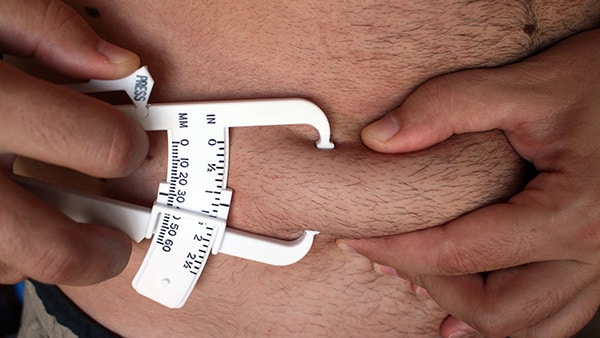
En effet, lorsque vous perdez 300 grammes de votre poids, l’idéal est que vous perdiez aussi un centimètre de tour de taille. Dans le cas où vous perdriez beaucoup de poids, mais que votre tour de taille ne diminue pas en conséquence, cela signifie que vous perdez de la masse musculaire, mais pas assez de masse adipeuse.
S’observer dans le miroir est également un bon moyen de voir une évolution. D’où l’importance de prendre des photos avant, pendant et après votre sèche.
Au final, le meilleur indicateur d’une bonne sèche reste la mesure de votre taux de masse grasse. Pour cela, vous pouvez utiliser une balance à impédancemètre ou une pince à pli cutané.
Sauf en cas de surpoids très important, vous devrez viser une perte d’environ 2 kilos par mois.
En fonction de vos résultats, réajustez régulièrement votre apport calorique en diminuant la quantité de glucides jusqu’à atteindre l’objectif visé.

Conclusion
Vous savez maintenant comment faire une sèche. Une fois cette période terminée, vous paraîtrez plus musclé et plus volumineux. Votre définition musculaire sera bien meilleure, tout simplement car vous aurez perdu du poids et conservé votre masse musculaire.
Vous l’avez compris, votre alimentation est la clé du succès. Mais un régime de sèche ne doit pas être synonyme de privation et de frustration. L’objectif n’est pas de maigrir vite, mais bel et bien de mieux manger pour perdre du gras intelligemment. Et pour aller plus loin, voici 10 conseils pour ne jamais avoir faim en phase de sèche.
FAQ
Une sèche est une phase où l’on réduit son taux de masse grasse tout en préservant au maximum la masse musculaire. Elle repose sur un déficit calorique contrôlé et un entraînement adapté.
Il est conseillé de commencer une sèche après une phase de prise de masse, lorsque le taux de masse grasse dépasse environ 17 %.
Il faut déterminer son besoin calorique total, puis réduire l’apport d’environ 15 % pour créer un déficit. Un calculateur en ligne peut aider à ajuster les quantités.
Les protéines maigres (poulet, poisson, œufs), les glucides à faible indice glycémique (patate douce, riz basmati) et les bonnes sources de lipides (avocat, huile d’olive) sont essentiels.
Oui, mais en quantité modérée. Le HIIT peut accélérer la perte de graisse, tandis que le cardio modéré aide à brûler des calories sans nuire à la masse musculaire.
En général, une sèche dure environ 3 mois. Une perte de 2 kg par mois est une bonne moyenne pour préserver le muscle.


